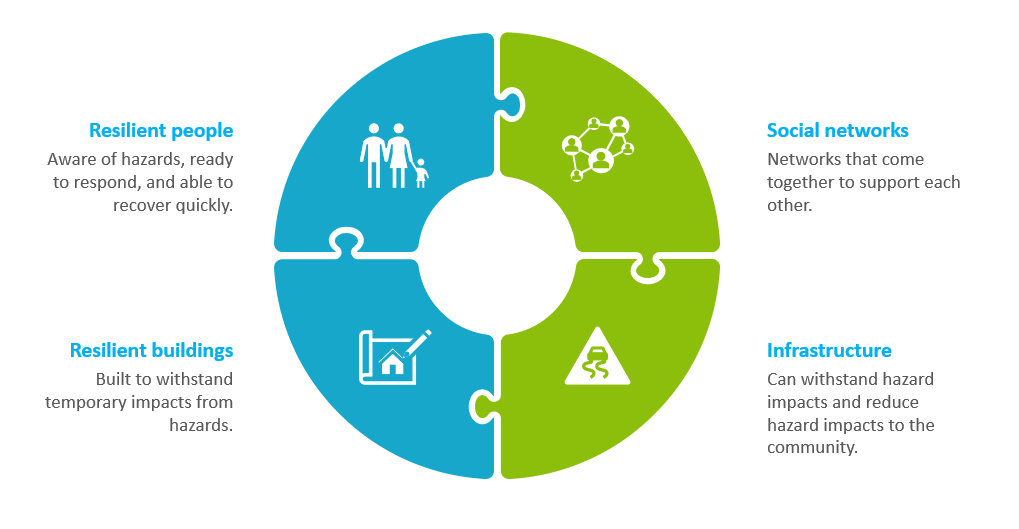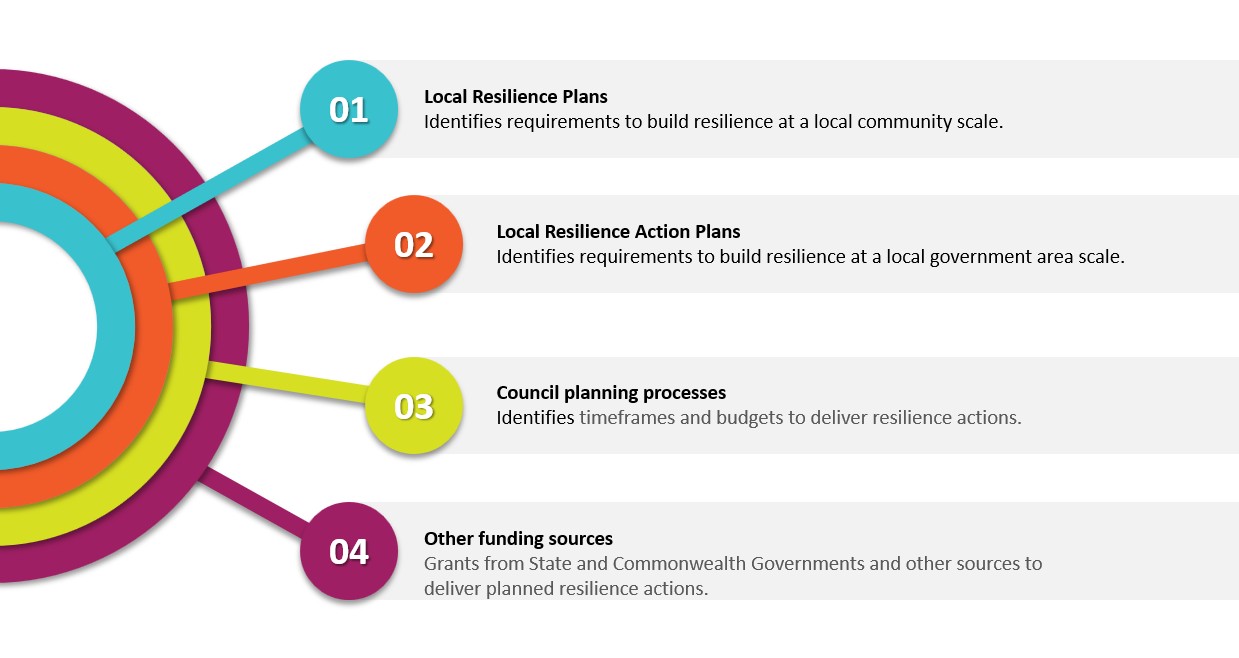Protecting a unique coastal village
We can't prevent natural disasters or climate change, but we can make sure we are prepared.
Donnybrook and surrounding areas are at risk from natural hazards like floods, bushfires and tidal inundation. Climate change projections indicate these impacts will worsen over time. Without action, some parts of Donnybrook will become unsafe to live in and Council will need to start planning for changing land uses in the future.
Local Resilience Plans
A Local Resilience Plan is an area-specific plan to improve community resilience to natural hazards such as flooding and sea level rises.
By working together we can protect Donnybrook for decades to come. Planning for changes now will empower residents and property owners to make decisions on how and when they make improvements to their properties in the future. The goal of Local Resilience Plans is to achieve resilience by 2050 and prevent or delay the need to transition land uses.
Get involved in creating a resilient Donnybrook
Review the draft Local Resilience Plan and the supporting information on this webpage. You can also see what people said about the draft plan.
☔A resilient community
A resilient community is socially connected and has infrastructure that can withstand disaster and foster community recovery. They understand, prepare and manage possible impacts from natural hazards to properties and homes.
The four key elements of a resilient community are:
- resilient people
- resilient social networks
- resilient buildings
- resilient infrastructure.

Resilient people are prepared for natural disasters, ready to respond, and able to recover quickly afterwards. Having an Emergency Plan and an Emergency Kit are the first steps to to ensuring your family, your home or your business are resilient.
The most resilient communities are the ones that pull together during times of need to help each other. Creating good social networks will help make your whole community safer.
A resilient building is designed to withstand and reduce the impacts of natural hazards. Some simple changes to your home, like replacing carpets with sealed tiles, can reduce the damage caused by natural disasters and speed up your recovery. Don’t forget to make an Emergency Plan for your business so it can get back to work quickly after a disaster.
Infrastructure plays an important role in reducing the impacts of natural hazards on communities. Improving infrastructure like roads and utilities (power, water, etc) can help make communities more resilient to disasters. Some infrastructure like seawalls or drainage systems can reduce or prevent some impacts in the community.
As part of the Local Resilience Plan project for Donnybrook, Council has identified opportunities for infrastructure to reduce hazard impacts and improve community resilience. We also know that high tides can push back on drainage systems, exacerbating the problems. Council will undertake more investigations into these drainage issues to identify the most effective solutions.
We are committed to working in partnership with the community and will consult you about the infrastructure options identified as we continue planning. This is a long-term process. It is important we get these solutions right, so they provide the benefits we need now and for the future
📒Local Resilience Plans
Local Resilience Plans form the foundation of our long term planning to make at risk communities more resilient. They help us identify needs at a local community scale and embed them in long term Council planning processes. This helps us identify opportunities to apply for grant funding from State or Federal Governments and other programs.

🗨️Previous consultation
Consultation with residents of Donnybrook has been a critical part of developing the draft Donnybrook Local Resilience Plan.
- In 2023 Council consulted residents in Moreton Bay's coastal areas about natural coastal hazards as part of the Living Coast Plan. Donnybrook residents told us they knew their community was at risk, and they wanted to take action to protect their properties and preserve their community.
- In 2024 Council invited residents of Scarborough, Donnybrook and Dohles Rocks Village (Griffin) to form a Community Resilience Task Force and work with us to develop localised resilience plans. This was a pilot project, where both Council and task force members learnt from each other about the resilience needs of each community.
- Between late 2024 and mid 2025 we held a series of Community Resilience Task Force workshops to identify local risks and impacts, both now and into the future, and identify resilience actions to protect communities. The results of workshops were shared on the project website for each community, where other residents could add feedback if they wanted to.
Community Resilience Task Force workshops
Check out what we heard from residents in Local Resilience Task Force workshops.
Local Resilience Plan pilot project
Climate change modelling shows the following future risks:
- The risk of erosion may increase, particularly for properties along the Esplanade and at the northern end of the community.
- Tidal inundation is expected to increase in already affected areas by 2050. By 2100 it could impact most of Esplanade Road North and some parts of Ann St and Alice St.
- Storm tide inundation is expected to increase by 2050 and may impact properties on Esplanade Road North, Ann St, Amy St and Alice St. By 2100 it is expected to impact most of the northern part of Donnybrook.
- Risks associated with overland flooding, severe storms and cyclones, bushfires and heatwaves are expected to increase for all City of Moreton Bay communities.
There are many actions that can be taken by Council to reduce the impact of natural hazards on the community. However, there is much more that needs to be done in order to improve long-term resilience.
This includes Council improving local infrastructure and residents making changes to homes and properties.
Projections of future climate change risks indicate there may come a time where parts of Donnybrook become unsafe to live. The Local Resilience Plan project aims to create a resilient community by 2050 so we can delay or avoid the need to transition land use.
Whilst it is impossible to completely remove the risk posed by natural hazards, a resilient community has the ability to withstand, adapt to, and recover from natural hazard impacts over long periods of time.
A resilient community is socially connected and has infrastructure that can withstand disaster and foster community recovery. They understand, prepare and manage possible impacts from natural hazards to properties and homes.
New or improved infrastructure can help reduce the impacts.
Recommended actions include simple, low-cost actions - like clearing roof gutters, removing tree branches close to your home and preparing an emergency kit.
The Local Resilience Plans also include longer term actions for property owners to plan ahead, such as using water resistant materials where possible.
There are a number of actions that Council or the State Government can take to reduce the impact of natural hazards on the community - but it's not enough.
To achieve long-term resilience we need to improve local infrastructure as well as making changes to homes and properties. By working together, we can protect the assets and lifestyle of Donnybrook for decades to come.
As part of the development of this Local Resilience Plan, consultations revealed the following concerns raised by residents of Donnybrook:
- Worsening impacts of localised flooding.
- About the rising costs of insurance, and in the future, the ability to even obtain insurance.
- Increasing local development, changing drainage volumes, and increased overland flows
- The lack of suitable drainage (additional pits/stormwater drains required).
- Effectiveness of coastal drainage infrastructure (e.g. duckbill outlets).
In response, Council is working on several investigations at Donnybrook. These investigations, along with ongoing infrastructure upgrades, will help us identify, plan, design and deliver long-term infrastructure responses to natural hazard risks:
Southern Pumicestone Passage Shoreline Erosion Management Plan
Delivering complex infrastructure projects takes time. We will continue to keep the community informed of progress on all investigations, advocacy efforts and projects.
We don't have a crystal ball, but the information we have suggests that the risks from natural hazards like bushfire, flood, and tidal inundation are only going to get worse in the future.
While there are no guarantees, the earlier both Council and property owners take action, the more likely we are to avoid a situation where these areas become unliveable.
If we work together to improve the resilience of Donnybrook, then we will be able to continue to manage those risks and adapt to living with them.
Without improvements to both infrastructure and private assets, then the local area may become unsafe for homes at some point in the future.
Moreton Bay City Council (Council) is collecting your personal information for the purpose of informing the Donnybrook Resilience Plan pilot project. Council will also use your contact information to update Council’s customer information records and to contact you about the Project and other functions, services and projects of Council. Council may use the information you provide to inform our other functions, services and projects.
This project has received funding support from the Queensland Government.





